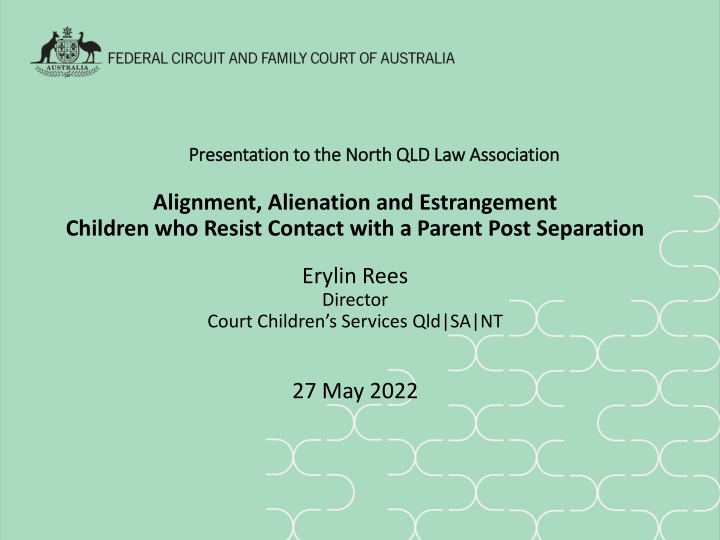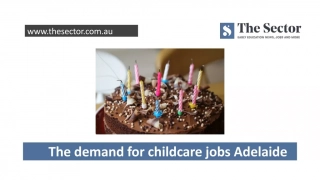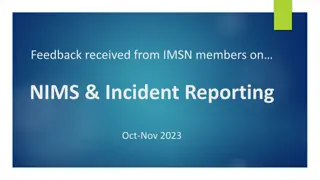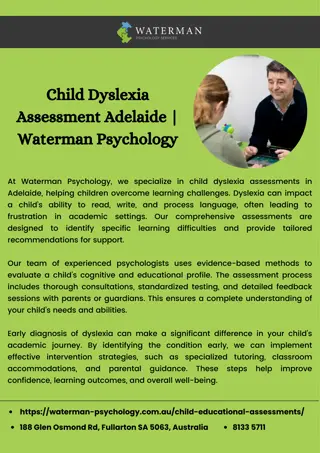NAFEA Conference Adelaide 2017 Data Reporting Workshop
This report discusses the importance of creating data reports in the context of Deakin University's School of Education, focusing on gathering, creating, and presenting data related to placement officers. The report covers various aspects such as information for problem-solving, audience analysis, and sample questions sought for data. It also delves into the challenges, achievements, and staffing needs within the educational sector.
Download Presentation

Please find below an Image/Link to download the presentation.
The content on the website is provided AS IS for your information and personal use only. It may not be sold, licensed, or shared on other websites without obtaining consent from the author.If you encounter any issues during the download, it is possible that the publisher has removed the file from their server.
You are allowed to download the files provided on this website for personal or commercial use, subject to the condition that they are used lawfully. All files are the property of their respective owners.
The content on the website is provided AS IS for your information and personal use only. It may not be sold, licensed, or shared on other websites without obtaining consent from the author.
E N D
Presentation Transcript
Presentation to the North QLD Law Association Presentation to the North QLD Law Association Alignment, Alienation and Estrangement Children who Resist Contact with a Parent Post Separation Erylin Rees Director Court Children s Services Qld|SA|NT 27 May 2022
Introduction Introduction Part 1 Understanding alignment and rejection Part 2 Assessing alignment and rejection Part 3 Therapeutic interventions with alignment and rejection
Parental Alignment and Rejection Parental Alignment and Rejection The concept of children s minds being poisoned dates back 100 years Term of PAS coined by Gardner in 1985. PAS described common patterns of behaviour of aligned parent to promote rejection of other parent leading to the child refusing visits and rejecting a parent
Reformulation Reformulation PAS is a simplistic approach Few, if any, cases pure alienation Irrational rejection of a parent by child due to campaign of denigration. Differentiation of child alienation and realistic estrangement Na ve , active and obsessive alienating parents Even children who have experienced abuse can have attachment to and desire to see the abusive parent . Witnessing family violence can turn the child against the abuser or against the victim
Dynamic factors Dynamic factors Children resisting time with a parent is dependent on a number of factors including each parent, extended family, siblings, aligned professionals importantly the child s experiences
Reformulation of parental alignment and rejection Reformulation of parental alignment and rejection Kelly Kelly and Johnson (2001) and Johnson (2001) The alienated child (refined Johnston and Sullivan 2020) A child who expresses strong negative feelings and beliefs about a parent that do not reflect the child s prior experience of that parent. The alienated child demonstrates contemptuous and aggressive behaviours towards the rejected parent that are developmentally inappropriate. The alienated child s beliefs can be irrational or exaggerated, and are significantly disproportionate to their actual experience. Does not include children who have experienced child abuse or Does not include children who have experienced child abuse or family violence perpetrated by the parent they are rejecting family violence perpetrated by the parent they are rejecting.
Johnston and Sullivan/ Parental Alienation: In Search of Common Ground For a More Differentiated Theory Family Court Review, Volume: 58, Issue: 2, Pages: 270-292, First published: 28 April 2020
Dynamic and facilitating factors Dynamic and facilitating factors Child factors Parent conflict before and after the separation; Sibling relationships; Parent factors Adversarial process/litigation; Aligned professionals and extended family; and Coparenting hostility
Adapted continuum of strained parent-child relationships Polack and Saini 2015
Non Non Aligned children / Affinity to one Parent Aligned children / Affinity to one Parent Positive relationships with both parents and child able to see some negatives about each Differences in the child s attachments and relationships with each parent, dependent on personalities and family roles. Affinity towards a parent is flexible and can change over time with child s expected development and changes in family. (e.g. younger children often prefer primary caregiver, middle childhood affinity for same gender while adolescence prefer least restrictive)
Aligned children Aligned children Children can be aligned with one parent for a range of different reasons relating to parenting style, gender, age, personality and interests. Mild to moderate alignment with one parent is not uncommon in functional families and can vary depending on parenting roles, children s ages and other variable factors Siblings may each have different alignments Aligned children do not completely reject the nonpreferred parent but are ambivalent about time May be the result of one parent insensitivity and poor parenting skills, absence sense of moral indignation at separation
High conflict splitting In high conflict separations children can be triangulated into the conflict and need to pick a side as an emotional survival mechanism. Children aged 9-11 are particularly vulnerable to this. Younger children can split their experiences with both parents and appear to each parent to be rejecting of the other parent Adolescence tend to be reflective of both sides
Rejecting children Children can reject a parent due to their direct experience of mistreatment, assault or abuse of themselves or someone else by that parent. This can include emotional abuse and be related to separated associated conflict or violence The parent s willingness, or lack thereof, to acknowledge their violence or mistreatment and it s effect on the victim(s) can also be a significant factor in the child s rejection. A parent s negative, critical or rejecting responses to a child s alignment to the other parent can contribute to rejection of that parent. Conditional love can lead to alignment and rejection: e.g. I love you if you only love me .
Realistically estranged children Realistic estrangement is a justified, protective, and adaptive response to experience of trauma Rejection of one parent due to child s experience of the actions of that parent Emotional distress experienced is congruent to their actual experience May include emotional or physical trauma Child may have some emotional ambivalence about the rejected parent, but unequivocal about no contact. Favoured parent s behavior may reinforce child s position Risk of re-traumatisation if forced contact
Alienated children Child s resistance primarily result of alienating parent s conduct. Prior to the separation the children had a good enough relationship with the parent Near or complete rejection of one parent by the child with little or no ambivalence about the rejected parent or the loss of a relationship with them. Tend to use same language or complaints as the aligned parent. Fusion or enmeshment in the thinking of the child and the parent they are aligned with. Vague, false or exaggerated claims against rejected parent. Tendency to become over involved in adult matters and disputes and have strong views on adult issues such as financial matters. Act as a spy for aligned parent if visiting rejected parent Most obvious and entrenched in older children: 8 16 years Younger children can still be aligned but are less likely to maintain a strong rejection when they spend time with the rejected parent. Rejection of the parent tends to increase with less time spent with that parent.
Parental Alienating Behaviours Johnston and Sullivan (2020) have defined PAB as: an ongoing pattern of observable negative attitudes, beliefs and behaviors of one parent (or agent) that denigrate, demean, vilify, malign, ridicule, or dismiss the child s other parent
Aligned Aligned Parent Parent Na ve Passive about the child s relationship with other parent Critical of other parent, including to child Accepts time with other parent where it is not problematic Unaware of the influence they have on the child s views/ feelings Exposes child to their perspectives on parent conflict. Active knowingly attempts to influence the child to reject other parent Has own motives based in their experience of or attitudes to the relationship/separation Is aware their actions are seen as wrong and attempts to conceal their actions and motives Escalates conflict Obsessive Denigration of other parent open and directly to the children Rarely has insight or self control Determination to destroy child s relationship with other parent and exclude them from their own and the child s life May be a perpetrator of family violence/child abuse various types and degrees May have personality disorder or psychiatric illness
Rejected Parent Rejected Parent Positive Maintains a positive stance in relation to both the children and the other parent. Wants to minimise conflict and maintain their relationship with the children. Often confused and saddened by rejection. Engages well with the children when with them, working through resistance in positive ways. Reactive Reacts angrily to rejection, both to children and other parent. Escalates conflict. Critical of other parent sometimes to children. Can be positive with children if they are not difficult or resistant. Abusive Denigration of other parent open and directly to the children. Angry and blaming. Perpetrator of family violence/child abuse various types and degrees. May be causing realistic estrangement
Impact on children Impact on children Extensive research shows children of separated parents show better outcomes, emotionally, socially and academically when they maintain a relationship with both parents Relationship problems Lack of empirical research on long term impact of strained relationships between children and parents Depends on severity, intensity of alienation and vulnerability of child Age of the child
Assessment Assessment
Risks Risks Bias; Polarised and only focus on favoured or rejected parent Not screening for fv, child abuse/neglect, substance abuse, mental illness Only focus on child/ information from child s therapist
Abuse allegations Abuse allegations Need to be assessed by Child Protection Authorities Danger of system abuse to child of multiple interviews Bias (occurred or is fabricated)
Assessment of Parents Assessment of Parents Parents; attitude, beliefs, behaviours Capacity to support relationship History of family relationships Capacity to be child focussed Capacity of rejected parent to be a caregiver Allegations of fv, child abuse; Impact of ongoing court proceedings
Assessment children Assessment children Child; temperament, resilience, overall functioning Experience of abuse or neglect, direct/indirect Understanding of separation and conflict Experience of the rejected parent How the child has formed their views, have these views changed over time of not spending time with the rejected parent Willingness to engage with parent, (how observations relate to interview responses) How would child react if Ordered to spend time with a rejected parent Impact of ongoing court proceedings
Interventions Interventions Forensic assessment goal to provide information for Court processes, relies on neutral stance. Therapeutic work relies on a therapeutic alliance involving building trust, providing a safe environment to explore and be vulnerable to expose self and try new behaviours. When boundaries are crossed people will not be as open to the impact of therapy Therapy can be effective after Orders change situation
I Interventions nterventions
Development of resistance to contact is complex and multi-determined. It is important court processes do not contribute Need to be move beyond polarised responses Multiple interventions including psychoeducation, CBT, behavioural skills training, family therapy depending on individual assessment of family
Progression of interventions Progression of interventions Information to parents Therapy Focussed Intervention/ Reunification Change of caregiver (risks) Court Orders Consequences
When rejection is mild When rejection is mild Therapeutic input; with child to develop strengths, resilience and healthier attachments with rejected parent : to develop empathy for the child s emotions and needs and understanding of the children s perspective with favoured parent: to appreciate advantages for children to have a relationship with both parents Education for parents, eg POP programmes and parenting capacity programmes Supervised third party handover Gradual increase in time
When rejection of a parent is moderate When rejection of a parent is moderate Have assessment of individual family situation child s previous relationships and current views Reunification therapy Clear orders Counselling for parents to develop parallel rather than cooperative parenting practices Supervised time Orders for extended time with rejected parent
When rejection of a parent is absolute When rejection of a parent is absolute Looking for the least detrimental solution short and long term Assessment of risk to stay with favoured parent. Clear and specific Orders (involuntary participants in treatment) Can rejected parent care for the child No research on change of residence success Weigh up competing risks eg; Consider how child will react/ running away/ self harm If rejected parent is to walk away assistance with ways to keep the door open for future contact Favoured parent to keep rejected parent informed of child s progress
Factors for success Factors for success Early intervention Younger age of the child Realistic expectations/ connections not nec contact Capacity of parents to communicate Co-parenting dynamics Ability of parent to have good experiences with the child Absence of abuse Clear court orders to the protect the child s relationship with both parents.
Case Example Case Example Oscar s parents separated when he was 6 years old Prior to the separation the mother was the primary caregiver while the father was a FIFO worker spending 4 weeks away and 2 weeks at home Rel ship before sep is described differently by parents with the mo describing the fa as being controlling and the fa describing verbal conflict At sep Oscar continued to live with mo and spend time with his father when he was in town Oscar became increasingly reluctant to spend time and by the age of 8 refused to spend time
Mo says Oscar experienced fa being abusive to her and that he had physically disciplined Oscar Fa says time was fine before he repartnered. Fa also says while Oscar initially protested at sep from mo he would settle once in his care Mediation was attempted with no success A counsellor has interviewed Oscar and his mo and is concerned Oscar might have experienced more abuse at his fa s hands
Child Factors Child Factors Oscar is a boy who has learning difficulties and struggles with his peer group at school He has missed a significant amount of time at school He identified that he is close to his mo who provides for his needs
Aligned mother Aligned mother Described the fa as being absent in first years and only having a rel with Oscar because she supported it Grief at the end of the marital rel Fear that the fa would let down Oscar in the future Powerless to force Oscar to go against his will to his fa
Rejected father Rejected father Agreed Oscar has a good rel with his mo and that she has met the majority of his needs Thought the mo was refusing to allow Oscar to have a rel with him due his new rel and mo and her family are denigrating him to Oscar Agreed the marriage had been conflictual although mutualised the conflict
Issues to explore Issues to explore How can Oscar s individual characteristics/ vulnerabilities be explored? What might be looking for? What further information would be useful to know from outside agencies? What weight should be placed on the counsellor s opinion? What parental factors need to be taken into account? What could assist Oscar and his parents in this situation?
Challenges Challenges Can alienating parents be good enough parents? At what age is it too late ? Early intervention is most likely to succeed, but is more likely to be based on incomplete assessment. The use of court processes increases pre existing negative feelings of children towards a rejected parent. Is the emotional and relationship damage associated with court action worse for the child than the long term harm of the alienation?
Questions Questions























